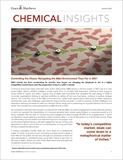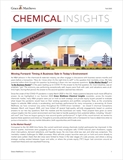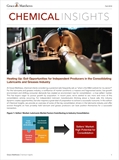Chemical Insights Newsletter
Chemical Insights Newsletter
Each quarter, Grace Matthews publishes a newsletter that features articles about trends in the chemical industry, highlighting a different sector every issue. Click below to read our recent issues. If you would like to receive a hard copy of any, please contact Elizabeth Jasinski at 414.278.1120 or ejasinski@gracematthews.com.

Looking back just a couple months to the start of the new year, positive vibes ruled the day, with numerous tailwinds seemingly setting the stage for broader economic growth and increasing M&A activity. Today, as we approach the end of the first quarter, we remain confident in growth in both the chemicals & materials science industry as well as overall M&A activity in the year ahead. However, we also need to acknowledge that the tone in the industry is now balancing positivity with a general sense of uncertainty. Industry executives are seeking elusive answers to basic questions: What is actually happening with demand? How are demand trends varying across geographies? When will we finally know the scope and extent of potential tariffs? And how might all these impact the outlook for the rest of the year? One thing is clear: 2025 is the year managers get paid to manage!
For many in the chemicals and materials value chain, this year has been a rebound from the uncertain demand patterns and rippling effects of destocking that we saw in 2023. Throughout 2024, we have remained quite active, and the developments we have seen over the course of the year support this growing momentum. The result has been an increasingly competitive M&A market in 2024 that we anticipate to continue into 2025. To succeed in this competitive arena, buyers will need to develop a specific and well-articulated acquisition strategy, commit real resources to this strategy, and identify ways to differentiate themselves versus others. In this edition of Chemical Insights, we discuss these strategies in more detail and conclude with our thoughts and expectations for 2025.
As we discussed in our most recent newsletter, the chemicals and materials science value chain seems to be returning to a period of normalized performance, as production outputs more closely reflect actual market demand. Recent shocks in supply chains that manifested in increased inventory levels and subsequent destocking have subsided, and the industry has relearned a critical lesson from the volatility — the importance of supply chain reliability. The value delivered by capable distributors of chemicals, ingredients and other specialty materials during this period became apparent, and many have seen their businesses flourish despite periods of choppiness as the destocking dynamic played its way out. In short, distributors are doing more and are being paid for doing it. We have also seen a continuation of the long-term trend toward increased M&A activity, particularly among distributors. The elevated importance of distributors, coupled with a highly fragmented distribution landscape, creates a strong environment to support inorganic growth and is the focus of this edition of our Chemical Insights newsletter. We also reflect on and thank our current and former clients as Grace Matthews celebrates its 25th anniversary milestone.
As the new year continues to unfold, we are embracing the growing sense of optimism for an uptick in M&A activity for manufacturers, distributors, and service providers in the broader chemicals & materials science value chain in 2024. While 2023 was a robust, near-record year for Grace Matthews, we recognize this was an anomaly relative to industry trends. Many factors (rising interest rates, inflationary pressures, and pricing increases, to name a few) contributed to a challenging 2023 M&A environment, but one phenomenon touched nearly every company we worked with or spoke to: inventory destocking and its negative impact on demand. In this newsletter, we examine if inventory destocking is behind us and if this means the industry is entering a period of “normalized demand”. If so, will the potential end of destocking serve as a catalyst for increasing M&A activity in 2024?
The M&A environment and broader economy have had an eventful last few years, and 2023 has been no different. While news headlines often skewed negative throughout 2023 (such as speculation about a looming recession), there are signs that the worst of these concerns have subsided, particularly as recent inventory destocking effects are behind us, and more companies are beginning to see signs of a return to more predictable demand patterns. The improving outlook across the chemicals and material science industry, combined with the slowdown in M&A in 2023, is contributing to an increasing backlog of potential transactions for 2024 in what many believe will be a stronger year for the broader M&A market. Such market dynamics beg the question we have been asked more frequently in recent months: “When is the right time to start a sale process for my business?” In this edition of Chemical Insights, we offer an update on M&A market conditions and highlight the importance of customer demand predictability on M&A transactions. In our view, confidence in a company’s forecast has become the most critical diligence topic for potential buyers and correspondingly the most relevant for sellers to achieve a successful sale.
Over the past quarter, news headlines have seemed skewed even more negative than usual: recessionary concerns, supply chain disruptions, banking liquidity, inflation, rising interest rates, geopolitical uncertainty & conflicts, debt ceiling showdowns, and more. Much has been written about these macroeconomic events, and we can concisely summarize them with a simple, obvious statement – there is significant uncertainty in the market. That being said, buyers and sellers are successfully navigating the current environment, and transactions are getting done. In this Summer 2023 newsletter, we share real-time insights from industry leaders on the pricing and volume dynamics rippling through the industry. Importantly, we highlight what these dynamics mean for M&A.
In this issue of Grace Matthews’ Chemical Insights, we reflect on the ups and downs of the chemicals & materials M&A market over the past year and how the market remains positioned for opportunity in 2023. We also take a deep dive into corporate divestitures, an area Grace Matthews has spent substantial time on over the past several years and a segment of the M&A market we expect to see continued activity in.
The Specialty Ingredients market features a host of attractive characteristics, such as strong organic growth, products critical to end product performance, high recurring revenue, and high market fragmentation. For many investors, Specialty Ingredients “checks every box”, which has created a fertile ground for M&A. In this edition of Chemical Insights, we profile the Specialty Ingredients market, and provide an update on M&A market conditions amid the tumultuous macroeconomic environment we’ve experienced so far in 2022. We are witnessing an ongoing “flight to quality” effect where high-quality businesses have continued to attract significant interest from strategic and financial buyers.
Despite current macroeconomic headwinds, buyer appetite for high-quality businesses has remained strong, and the M&A market remains robust. One industry segment in which we are particularly bullish about M&A is chemical distribution. M&A activity in distribution is not new, but strong financial performance by distributors, the critical nature of their role in light of recent supply chain issues, and continued buyer interest in building scale through acquisition are huge drivers of our optimism.
Following record M&A activity in the chemicals & materials industry in 2021, we discuss our expectation on how this momentum will carry into 2022 despite uncertainty driven by inflation, stock market volatility, supply chain disruptions, and continued COVID-19 impacts on operations. We also provide commentary on how buyers & sellers are navigating these dynamics in M&A processes and share our views on how bullish buyer and seller sentiment are likely to drive strong M&A activity in 2022.
In this latest newsletter, we discuss the increasing emphasis on Environmental, Social, and Governance (“ESG”) themes in the chemicals & materials industry, the evolving definition of ESG standards, and how companies can evaluate themselves and create value by emphasizing and embracing ESG standards. We conclude with a few observations of other trends and notable developments that we are seeing in this continued frothy and extremely competitive M&A market.
In the first half of 2021, M&A activity has been at or near record highs. Sellers looking to explore a sale process are met with buyers with aggressive appetites for transactions and record levels of capital. We are being asked, how are we navigating this uniquely chaotic M&A environment? What are buyers doing to win, and why is preparation the key in a seller’s market? In this edition of Chemical Insights, we offer up a few observations that exemplify the competitive dynamics we are seeing in processes today and touch on what it means for both buyers and sellers to succeed in a transaction process.
As we start the new year, the current M&A market has many similarities to the end of 2019: increasing deal activity in terms of both completed processes and projects being launched; strong appetite from both private equity and strategic acquirers; and an overarching sense of optimism in terms of deal activity and deal momentum. However, as we reflect on the year behind us and what lies ahead, we can all agree – the path from December 2019 to December 2020 was a (we hope) once-in-a-lifetime roller coaster. We often spend our newsletters focused on analyzing trends and data in a particular segment – in this issue we focus on reflecting on the year behind us and what we feel is ahead in the next couple of quarters.
As M&A advisors in the chemicals & materials industry, we often engage in discussions with business owners months and years before a transaction. “How do I know when it’s the right time to sell?” is the question that inevitably arises. Since the onset of the COVID-19 pandemic, this question became more difficult to answer. We help potential sellers think through this question by breaking it down into two separate questions: “Is the Market Ready?” and “Is the Business Ready?” In this edition of Chemical Insights, we explore these questions and share our thoughts to provide potential sellers with a framework for how to determine when to pursue a transaction.
After 2019 provided outstanding equity returns, as the S&P 500 was up ~30%, and M&A levels were strong, we began 2020 with all major stock indices trading at or near all-time highs and expectations of continued M&A activity. However, since our last newsletter, a global pandemic unfolded, and the full extent of its impact on the chemical industry is still unknown. Based on our conversations within our industry network and having advised on multiple transactions that closed since April 1, we can explain what we’ve seen unfold, what we’ve heard from strategics, private equity investors, and private business owners, and what we are expecting to drive deal activity in the near-term.
We begin 2020 with all major stock indices trading at or near all-time highs, and 2019 having provided outstanding equity returns with the S&P 500 up approximately 30%. Despite the market strength, we hear mixed reports regarding the outlook for 2020 for the global market and chemical industry, as well as for middle market chemicals M&A. In this issue of Chemical Insights, we dig deeper into the macroeconomic conditions, what it means for M&A in various sectors within the chemical industry, and why we recommend staying ahead of the curve going into 2020.
For the lubricants and greases industry, a confluence of market conditions: a massive and fragmented sector, low-growth environment and shifting consumer demands has created an environment ripe for consolidation – a true sellers’ market. For independent lubricant manufacturers thinking about a future sale, this industry dynamic creates opportunities, but also requires a great deal of preparation to achieve a successful outcome. In this edition of Chemical Insights, we provide an overview of some of the key consolidation drivers in the lubricants industry and offer several thoughts on how privately held lubricant and grease producers can best position themselves for a successful transaction.
In our previous newsletter, we described the state of the Chemicals M&A market and outlined our expectations and predictions for activity in 2019. One important prediction was our expectation for an increase in carve-out activity focused on asset pruning and portfolio management. In this newsletter, we dig further into carve-outs, outlining the various drivers of carve-out activity as well as key focus items to consider when embarking on a potential divestiture.
Through the first nine months of 2018, the public equities markets, particularly in chemicals, appeared to be trending toward a slightly positive year-end performance. However, the general decline in public equities in Q4 2018 threw a wrench into year-end performance. This, combined with slowing growth in Asia, potential tariff wars with China, and Brexit, has caused a noticeable degree of market anxiety. In this edition of the Grace Matthews newsletter, we answer the question, “What does this mean for M&A in 2019?” and discuss our views on why the door remains open for chemicals middle market M&A activity in 2019.
In such a hot M&A market in an already attractive industry, how can smaller and mid-sized F&F players position themselves to generate attractive exit alternatives and capture maximum value in a sale process? In this edition of the Grace Matthews newsletter, we offer several possible answers to these questions.
Our Spring 2018 edition of Chemical Insights is part two of a two-part series on the emergence of private equity in the chemicals M&A industry. In this issue, we discuss ways in which we believe strategic buyers can develop counter strategies and practices to increase their own competitiveness in M&A. Additionally, we examine a few key takeaways from the tax reform bill and their potential impact on chemicals M&A. You can also find a list of recent M&A transactions in the chemicals space, and the Grace Matthews Chemical Index.
Each quarter, Grace Matthews brings you a newsletter that features articles about trends in the chemical industry. Our Fall 2017 edition of Chemical Insights is part one of a two-part series on the emergence of PE in the chemicals M&A industry. The article goes in depth on how and why private equity wins deals. You can also find a list of recent private equity involved M&A transactions in the chemicals space, and the Grace Matthews Chemical Index.
Our Summer 2017 edition of Chemical Insights features an article on U.S. construction chemicals and its continued growth since the Great Recession, including a list of recent deals in the space, and the Grace Matthews Chemical Index featuring construction chemicals companies.
Our Spring 2017 edition of Chemical Insights features an article on value-added distribution in the M&A market, including a list of recent deals in the space, and the Grace Matthews Chemical Index featuring distribution companies.
Our Winter 2016-17 edition of Chemical Insights looks back at some of the impactful moments of 2016, as well as a preview of 2017. The publication also features a list announced transactions from 2016, and the Grace Matthews Chemical Index.
Our Summer 2016 edition of Chemical Insights shows how the entire value chain is affected when industry giants merge or are acquired, illustrated by a number of recently announced deals in the agricultural chemicals and coatings industries. The publication also features a list of recently announced chemical transactions with values over $1 billion, and the Grace Matthews Chemical Index.
The spring 2016 edition of Chemical Insights features corporate carve-outs in the industry as well as a list of the most significant corporate mergers, divestitures, and corporate carve-outs since the beginning of 2015, and the Grace Matthews Chemical Index.
The winter 2015-16 edition of Chemical Insights features the year in review from an M&A perspective, and how the industry may be undergoing a fundamental transformation. The publication also includes a list of the most significant deals this year, as well as the Grace Matthews Chemical Index.
The fall 2015 edition of Chemical Insights is focused on the paints and coatings market and the advantages of scale in mergers and acquisitions. The publication also includes a list of recent M&A transactions in the market, as well as the Grace Matthews Coatings Index.
The summer 2015 edition of Chemical Insights is focused on the adhesives and sealants market and how it continues to evolve through technology and the economy. The publication also includes a list of recent M&A transactions in the market, as well as the Grace Matthews Adhesives & Sealants Index.
For the first issue of Chemical Insights, we decided to feature water treatment chemicals and our views on some of the pitfalls of relying too much on average EBITDA multiples as a guide to valuing specific companies. It also includes the Grace Matthews Chemical Index, which tracks a time series of valuation multiples for 48 publicly traded chemical firms.































